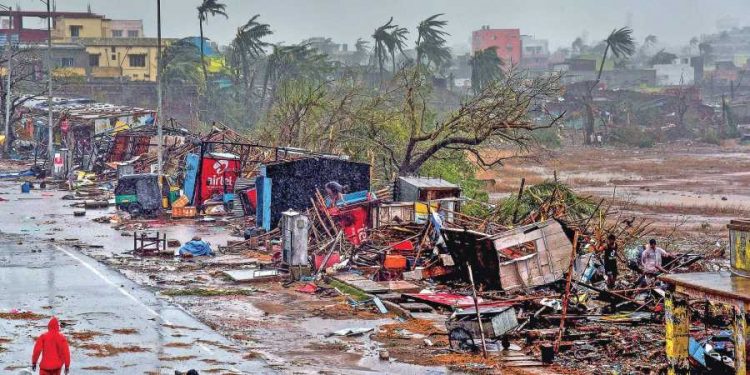Sanjay Kumar Rout
The Covid-19 pandemic has hit countries across the world, including India, resulting in vanishing economic activities, deaths and affecting millions of people. Meanwhile, the wrath of nature has left no stone unturned to hit human footprint menacingly. Economic losses are soaring. The recent floods, landslides and heavy rains that killed more than 125 people in Maharashtra are a burning example of nature’s wrath. In India, 60% of land is prone to earthquakes, 40 million hectares to inundation, 80% of land is exposed to cyclones, and 68% of the landmass is affected by drought.
The country is facing complications to cope with the devastating nature of frequent natural disasters in the 21st century.
A natural hazard becomes a natural disaster when the former batters human footprint. The drastic climate change snowballs into a natural disaster, affecting millions, killing thousands and extinguishing significant assets annually. On an average, 4,037 people died and over 4.9 crore were affected annually between 1980 and 2019. As a result, the country has to bear economic losses to the tune of over $2.7 billion due to natural disasters every year.
The Centre for Research on the Epidemiology of Disasters (CRED) has recorded 573 vital natural disasters between 1980 and 2019. Nevertheless, the frequency and magnitude of human and economic losses would have been substantially higher if one took into account the natural disasters at the local level. The annual average number of disasters was 11 and 11.7 in the 1980s and 1990s respectively in India. However, the frequency of natural disasters rose dramatically in the 21st century – from 11 in the 1980s to 18.6 in the 2000s to 16.1 in the 2010s. Natural disasters have increased by 69.09% between the 1980s and the 2000s and 46.36% between the 1980s and the 2010s. Although natural disasters have declined slightly in the 2010s compared to the 2000s, it was substantially high in the 2010s compared to the 1980s and 1990s. The considerable rise in natural disasters reflects the climate change impact in the 21st century.
The CRED classified natural disaster as meteorological (storms, extreme-temperature, fog), hydrological (floods, landslides, wave action), geophysical (earthquakes, volcanic eruptions, mass movements), climatological (drought, wildfire), biological (epidemic, insect infestation, animal accidents) and extra-terrestrial (space-weather). The share of hydrological disasters at 50.61% is high, followed by meteorological (33.16%), biological (10.30%), geophysical (3.66%), and climatological disasters (2.26%). Hydrological and meteorological disasters constitute 80% of natural disasters. Approximately, 90% of deaths occur due to hydrological (34.45%), geophysical (30.49%) and meteorological (25.32%) disasters. Hence, India must focus on hydrological, geophysical, and meteorological-related disasters to reduce human losses. Apart from deaths, around 94% of people are affected by climatological (54.70%) and hydrological (39.23%) disasters. The hydrological disasters accounted for 66.33% of economic losses worth $71.58 billion annually, followed by meteorological (23.06%/ $24.89 billion), climatological (5.69%) and geophysical (4.90%) disasters between 1980 and 2019.
Increasing population, urbanisation, environmental degradation and industrialisation accelerated the frequency of natural disasters in the 21st century. Ignoring the risks of natural disasters may hamper achieving several sustainable development goals. Natural disasters can also challenge India’s macroeconomic performance, reinforcing poverty and weakening economic development.
The natural disasters affected the marginalised sections more compared to the affluent sections, thus increasing economic and social inequality. In fact, such inequality has reached its peak in India in the post-pandemic period. Higher economic inequality implies reducing the marginalised section’s purchasing power and weakening consumption demand.
Thanks to the advancements in science and technology it has been possible to strengthen the timely warning and evacuation process, which helped reduce deaths tolls in the 2010s. Fatalities and affected figures have been decreasing despite increasing frequency of natural disasters. Yet, India is yet to mitigate the risks of natural disaster as still more than 2,000 people fall victims to natural disasters every year. We need greater attention and integrated efforts with proper strategy and technology to bring down the casualties below 1,000 annually. India has also failed to reduce economic losses due to disasters. The losses are growing continuously since 1980 due to lack of natural disaster-resilient infrastructure. India needs a better strategy, technology, and investment to cope up and minimise the risks and costs triggered by natural disaster.
The writer, a senior research fellow at Centre for Development Studies, Thiruvananthapuram, is currently working on ‘Natural Disasters in Asia’.






































